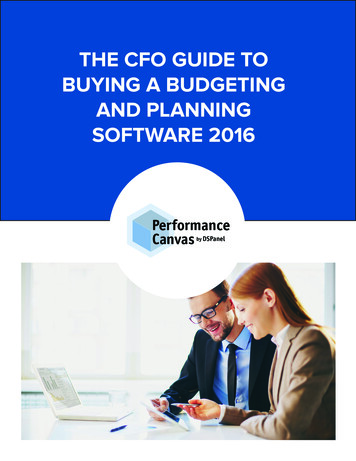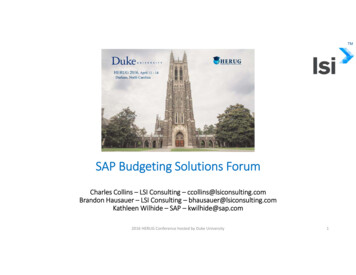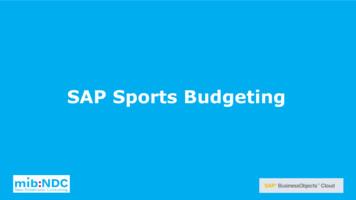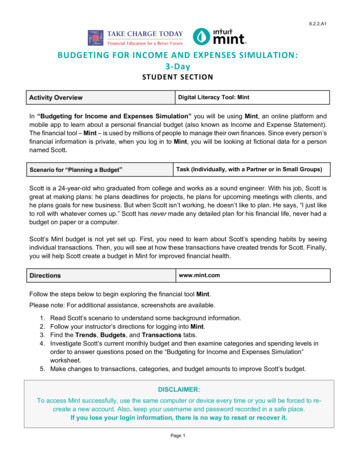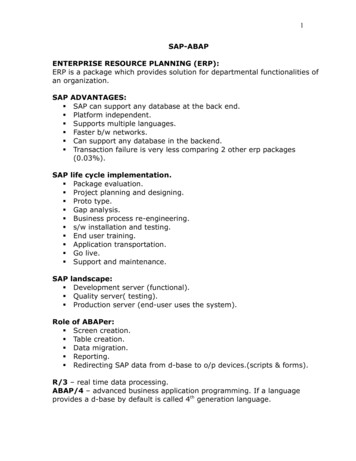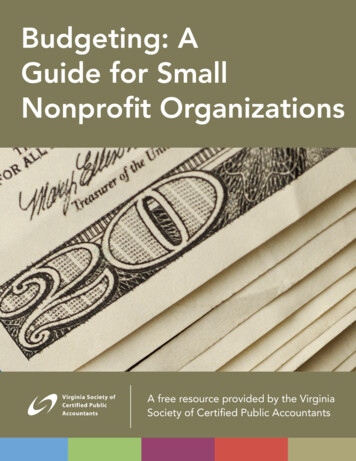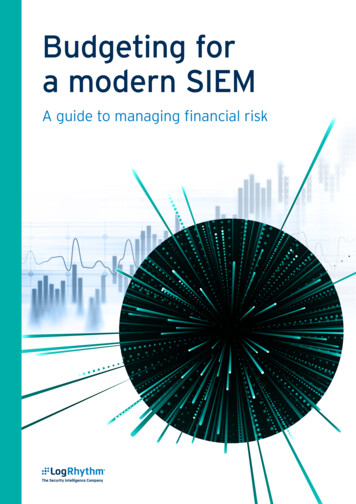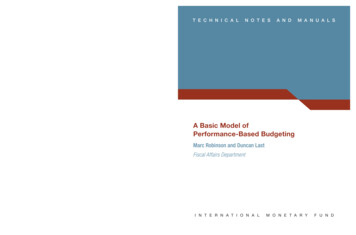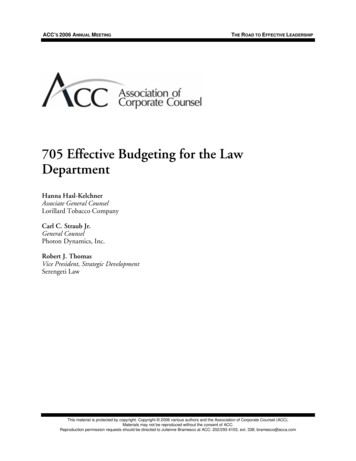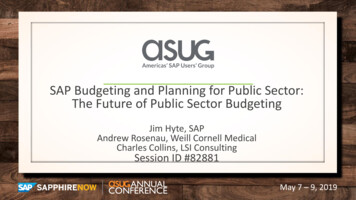
Transcription
SAP Budgeting and Planning for Public Sector:The Future of Public Sector BudgetingJim Hyte, SAPAndrew Rosenau, Weill Cornell MedicalCharles Collins, LSI ConsultingSession ID #82881May 7 – 9, 2019
Agenda Introductions and Product Review– Jim Hyte Case Study: How to Calculate ‘Fully Burdened’ Hourly Rates within SBP– Charlie Collins Weill Cornell Medical - Implementation Report & First Year LessonsLearned– Andrew Rosenau Q&A
Speaker IntroductionsAndrew RosenauCharlie CollinsJim HyteWeill CornellMedicineBudget DirectorLSI ConsultingBudgeting PracticeDirectorSAPPBF & SBPProduct Manager
Our Solution: SAP Budgeting and Planning forPublic SectorPowerful end-to-end public sector budgeting solution to supportdifferent budget approaches, processes and outputs Budget requests, reviews and adoption– Manage budgets in a single application Operating, capital and grants budgeting – A single application for all budgettypes User configuration – Tailor budget forms, process controls, reports and analyticsto your unique budgeting requirements and adapt them to changingrequirements Personnel cost forecasting – Examine and plan personnel expenditures at ahighly granular level to support budgeting, spending plans and collectivebargaining Modeling and analytics – Powerful modeling tools combined with the strengthof SAP Business Objects for reporting, dashboards and ad hoc analysis Text handling and automated budget book publishing – Prepare budgetdocuments that incorporate budgets, text descriptions, graphics and more Integration – Integration with SAP and non-SAP ERP systems
Product Roadmap, Cloud Version Update Planned release date: End of Q2, 2019 Will be called ‘SAP Public Budget Formulation, cloud edition’ SAP Cloud Platform (SCP) Full Native Cloud Solution, running on HANA Simple subscription pricing, includes maintenance and support services Functionality and Features taken from the current on-premisesolution PEP: Personal Expenditure Projections Flexible forms and budget process controls New! Form Designer Administration tools, Forms and all Navigation are in app andhave modern HTML5 user interfacesThis is the current state of planning and may be changed by SAP at any time.
More Information?Contact me following the presentationorVisit the Public Sector Industry booth on the showroom floorThis is the current state of planning and may be changed by SAP at any time.
Charlie CollinsHow to Calculate‘Fully Burdened’ Hourly Rateswithin SBP
The Client Context Capital Construction-Oriented Agency of a State Government Multi-Year Project Planning in SAP Portfolio & ProjectManagement (PPM) Application Planning Internal Labor Costs (Hours X Hourly Rate) Need ‘Fully Burdened’ Hourly Rate– General Management and Line Management Costs Need to be Addedto Line Staff Costs by Funds Center– Different Management Overhead Percentage for Each Funds Center– Output 35.43 per hour for a Maintenance Engineer in theMaintenance Branch of the Southern Region
SBP Solution – Step 1 General Management and Line Management Budgeting Form– Capture Operating Expenses and Equipment– Allocate to non-home funding sources for General and Line Management positions
SBP Solution – Step 2 Run a PEP Projection for All Employees and Vacant Positions
SBP Solution – Step 3 Custom Function Module to calculate ‘Line Management’ percentage and store ina benefit plan on each employee in a given ‘Line Staff’ Fund Center Triggered in ‘Create Labor Rates’ form
SBP Solution – Step 4 Re-Run the same PEP Projection for All Employees and Vacant Positions
SBP Solution – Step 5 Custom Function Module to calculate ‘Fully Burdened’ Line StaffHourly Rates Triggered in ‘Create Labor Rates’ form
Output – Table of Hourly Rates By Funds Center and Job Classification
Andrew RosenauImplementation Report &First Year Lessons Learned
OverviewFinances (millions)Clinical ServicesSponsored Research*Professional Education*Physical Plant (Usable Square Feet) 1,37427645WCMC-Q/ Other373Total 406,000Housing397,000Total1,970,000* NYC only Cornell University’s MedicalSchool in NYC founded in 1898 Partners with New York Presbyterian Hospital #9 Medical School in US NewsStudents (by Program)Faculty & StaffFaculty (Full-time)Non-Professor ,830Medical350Graduate School430MD/PhD140Other (incl. WCMC-Q)535Total1,455
Pain Points Prior to SBP, WCM Budget Office used Excel spreadsheets and Word documents tosend budget information out to departments Departments would fill out spreadsheets and then email to proper department forapproval Once approved, spreadsheets emailed back to WCM Budget Office who wouldthen upload budgets to ECC
SBP Implementation - Scope The scope of the project includes implementation of budgeting and Planningfunctionality for: Salary and Benefit Forecasting; Base Budgeting; Decision Packages; Monthly Budget Spread Workflow, Security and Reporting.
Our SBP System Landscape
Business Value Added: Systematically track departments budget inputs and report the status at any giventime using integrated reports. Accurate salary and benefit projection using PEP engine Detailed salary allocations of salary components Integrated system with SAP ECC, BW to extract HR/Financial data and retractapproved budgets back to ECC. New functionality for departments to monitor budgets by fund and reforecastperiodically. Ability to spread budget by month to better align budget with timing of actuals
PEP: The Secret Sauce PEP allows for complex salary & fringe benefit calculations at the EE level– Can run projections filtered by job, fund, pay group, etc– Can run simulations and populate the version you want– Very Stable Multiple Pay types: Base, Admin Supplement, Supplemental Compensationcombined with multiple fund allocations & specific fringe benefit calculations Use “Salary Proposal Form” as data-entry screen for increases/allocations/vacant &new positions
Salary Proposal Form
Salary Allocation Screen
Reporting: Position Budget Summary/Detail
So How did year 1 go? Went Live on 4/10/2018Over 2,100 Base Request Forms completed200 New Monies Requests/Temporary FundsOver 500 PEP projections runSuccessfully automated nightly retraction to ECCfrom “final” stage
Improvements for year 2 Successful rollover from FY19 to FY20 without LSI Small functional improvements/fixes to existing formsdone in-house Development of in-year forecasting functionality(summer 2019) Improved Reporting Implement Monthly Spread functionality previouslydeveloped
Lessons Learned Needs to be a equal partnership between Budget Office, ITS andImplementation Partner With SBP, the Budget Office is picking up responsibility formanaging an mini-HCM system. Budget office needs tounderstand how the relationships between Employee, Job, andPosition work Must have quality data in Development and QA environments.Bad data added time, and frustration to the project Budget systems run on a different schedule than otherenterprise systems – off cycle updates
Q&AFor questions after this session, contact us at:Jim – james.hyte@sap.com, Charlie - ccollins@lsiconsulting.com,Andrew – anr2060@med.cornell.edu
Take the Session Survey.We want to hear fromyou! Be sure to completethe session evaluation onthe SAPPHIRE NOW andASUG Annual Conferencemobile app.
Presentation MaterialsAccess the slides from 2019 ASUG Annual Conference here:http://info.asug.com/2019-ac-slides
Let’s Be Social.Stay connected. Share your SAP experiences anytime, anywhere.Join the ASUG conversation on social media: @ASUG365 #ASUG
Our Solution: SAP Budgeting and Planning for Public Sector Powerful end-to-end public sector budgeting solution to support different budget approaches, processes and outputs Budget requests, reviews and adoption–Manage budgets in a single application Operating, capital and grants budgeting –A single application for all budget typesFile Size: 1MBPage Count: 31
